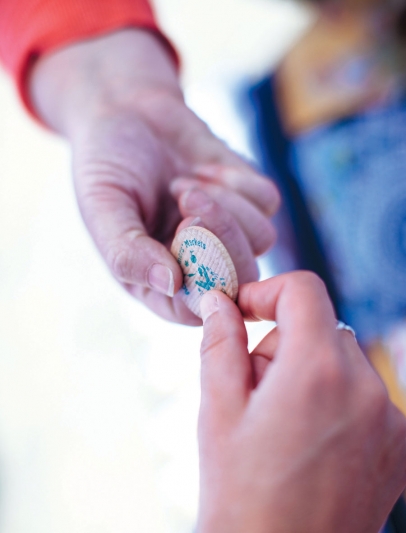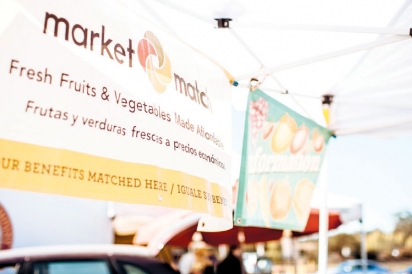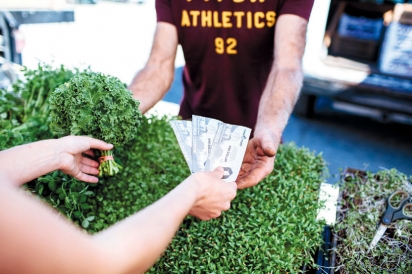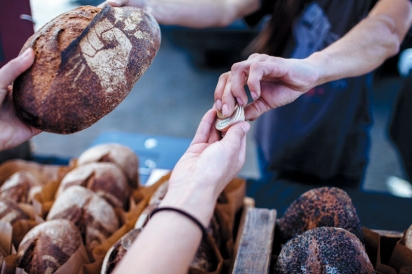SNAP and Market Match Program at Farmers’ Markets Makes It Easier to Eat Healthy
It’s a sunny late-September morning at the Santa Rosa Community Farmers’ Market and Sam Pratt, thin and brown-haired in a green T-shirt, approaches the information booth with reusable grocery bags in hand. He’s greeted with a smile by Jim Fenton, the market manager, who swipes Pratt’s electronic benefits transfer (EBT) card through a small machine similar to those used for credit cards.
Today, Pratt, who depends on CalFresh benefits to buy his monthly groceries, will use $20 of his monthly allotment to purchase food items from local vendors at the farmers’ market. But that’s not all. Thanks to Market Match, a statewide healthy food incentive program, he’ll receive another $20 in tokens for additional fruits and vegetables.
“I can get most of the products I would get at grocery stores here,” says Pratt, a soft-spoken 35-year-old teacher. “Once I found out that [Market Match] would match my EBT funds, I realized I could extend the benefits the state gives me a lot further by shopping at the farmers’ market.”
For his part, Fenton says he honors the EBT users who choose to shop at the farmers’ market and utilize the matching incentive. “We treat them like heroes for making this positive choice,” he says. Which is to say—in news that will come as a relief to anyone who has ever been shamed for relying on food stamps (this writer included)—negative connotations are off the table.
Pratt is just one of nearly 240,000 food-insecure shoppers in California to be served by Market Match, a program established in 2009 and run by the Berkeley-based nonprofit Ecology Center. In April 2015, the USDA announced its first Food Insecurity Nutrition Incentive grant by awarding $3.7 million to the Ecology Center for the expansion of Market Match. The program allows participants in CalFresh, referred to nationally as the Supplemental Nutrition Assistance Program (SNAP), to basically double their dollars at participating farmers’ markets.
It works like this: Someone spends $20 using their EBT card—which works like an ATM card but is filled with the user’s monthly Cal- Fresh benefits—at a local farmers’ market; thanks to the matching incentive, that person can receive another $10 to $20 (depending on the market) in tokens, to be used exclusively for fruits and vegetables. As a result of the USDA grant, 16 farmers’ markets in Marin and Sonoma counties were able to roll out expanded incentive programs under the Market Match banner last June.
Kelly Smith is the executive director of Agricultural Community Events Farmers’ Markets (ACEFM). The nonprofit manages 13 markets, including the Santa Rosa Community Farmers’ Market, and others in Fairfax, Novato, Marinwood, Petaluma, Rohnert Park, Cotati and Kenwood. Three years ago, before ACEFM joined the official Market Match consortium, Smith started her own incentive program at the Petaluma East-Side Farmers’ Market.
“The East-Side serves primarily a low-income area,” says Smith from the organization’s San Anselmo headquarters. “People often think of farmers’ markets as expensive or elitist; we wanted to establish a program for low-income Cal Fresh users to come over and shop the market.”
The incentive program was popular, but it was completely dependent on donations from large local health care providers like Kaiser and St. Joseph’s, along with generous community donors like the Santa Rosa Sunrise Rotary, who gave more than a $1,000 to the Santa Rosa market for incentives. Smith says they joined Market Match at the encouragement of the Rotary Club, to benefit from the strength of a branded, collaborative network.
Access to the two-year USDA grant has increased a sense of security all around. “The incentive is somewhat of a cushion for low-income EBT users, who tend to carry a general sense of insecurity,” Smith says. “Certain EBT users are ultra-insecure and hold on to their tokens. If you can lighten their load a little, it’s pretty rewarding.”
Smith’s group of markets officially joined the California Market Match consortium thanks to additional support from Petaluma Bounty, a nonprofit that brings affordable and healthy food to low-income people and seniors. Petaluma Bounty took on the role of third-party facilitator between Market Match and participating North Bay farmers’ markets. Petaluma Bounty Program Director Suzanne Grady completes the back-end administrative tasks, record keeping, outreach, networking and marketing that comes with the USDA grant, so that busy market managers can focus on their jobs.
Since every dollar requested from the grant funds must be matched by a locally donated dollar, Grady also handles outreach to donors. The markets under the Petaluma Bounty umbrella go by the moniker Farmers’ Market LIFE (Local Incentive for Food and Economy).
“We are excited to be part of the bigger picture,” says Grady. “We are only as successful as the people who utilize the program and those who help provide the community matching. This is truly to benefit our small-scale farmers and make healthy eating the easier choice, but we can only be successful if we get the word out and grow the support.”
So far this year, Farmers’ Market LIFE has distributed over $15,000 worth of incentives. Since CalFresh users spent another $15,000 from their own benefits, that means that, so far, about $30,000 has gone to small-scale farmers and vendors.
In 2016, Market Match aims to distribute at least $100,000 in matching incentives at participating markets in Marin and Sonoma counties, says Carle Brinkman, a farmers’ market program manager at the Ecology Center. In addition to Petaluma Bounty, the organization partners with the Agricultural Institute of Marin, the nonprofit that runs year-round Thursday and Sunday markets at the Marin Civic Center in San Rafael, among other markets. With this year’s expansion into 16 markets, there’s been a “big jump” from just six North Bay markets in 2014.
According to Brinkman, in addition to getting more fruits and vegetables to food-insecure California residents, Market Match has had noteworthy secondary economic benefits. According to a 2013 survey by the Ecology Center, 80% of farmers selling at the participating markets reported that they’d sold more fruits and vegetables, 69% said they had served new first-time customers and 66% had realized higher profits since the program began. For example, many vendors use the incentive tokens—the equivalent of cash—to cover their booth fees.
“The program is not only serving low-income SNAP families,” says Brinkman. “It’s also helping small and mid-size California growers to see more profits. Those growers are going back to some of the most drought-devastated local communities, so the program is doing double- duty in that way.” If the grant is fully utilized, state-wide there could be an increased $9.8 million in new spending on locally grown fruits and vegetables.
Despite the win-win situation, getting the word out about Market Match continues to be a challenge. Many CalFresh users don’t realize that they can use EBT cards at farmers’ markets instead of grocery stores, much less the additional incentive for fruits and vegetables. To make it easier, the Ecology Center created an online, mobile-friendly farmers’ market finder at ecologycenter.org/fmfinder.
“We are continually trying to work on getting the word out to SNAP shoppers,” Brinkman says. “A big part of that needs to come from the local county social service department, the folks that are actually working with the clients to get them CalFresh benefits.”
Even if CalFresh participants aren’t able to find a Market Match provider in their area, they will probably have luck finding a farmers’ market that offers its own locally funded incentive, a growing trend. These markets might not use the Market Match branding, but the incentives, usually funded by community donors and local businesses, serve the same purpose: to stretch the dollar power of low-income shoppers.
Allen Thomas, market manager for the West End Farmers’ Market, which skirts a low-income, historical neighborhood in Santa Rosa’s downtown core, decided against joining the Market Match consortium through Petaluma Bounty.
“The paperwork and restrictions involved with getting money from the federal grant just wasn’t in line with what we were trying to do,” says Thomas, who has managed the market since it launched in 2013. Market Match restricts EBT users to using their tokens for fruits and vegetables, but at WEFM the incentive is open-ended. CalFresh users can spend it on meat, dairy, protein, basically however they want. Usage since the market’s first year has risen from $10 per market day to $100. This year, the market raised $4,000 from in funding from local donors, including Exchange Bank, Petaluma Poultry and Fogbelt Brewing. Next year, Thomas says, they hope to get to $6,000.
“I’ve seen young families and elderly being able to stretch their budgets at our market, get wholesome complete food, and be able to do it in an economical fashion,” Thomas says. “To me, that’s the neatest part of this matching program. It exposes a greater number of people to the benefits of locally grown and locally produced food.”
Back at the Santa Rosa Community Farmers’ Market, Sam Pratt, after a morning of shopping from his favorite farmer vendors, will return home with melons, salad greens and apples, all procured with his incentive tokens. Since Pratt started coming here regularly, he’s taken a free class on how to cure salmon, gained practice in prepping fresh food and learned how to buy only what he truly needs.
“Market Match is a great program for educating yourself about healthy eating and how to economize your dollar,” says Pratt. “People should come out and celebrate it, rather than push it away. There are a lot of great vendors here. Come out and check it out for yourself.”










